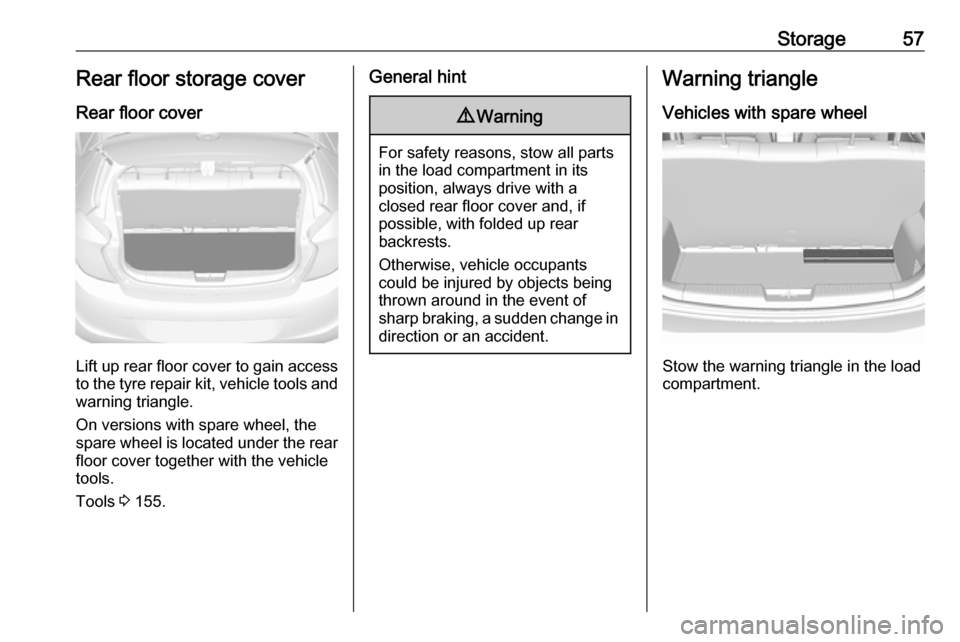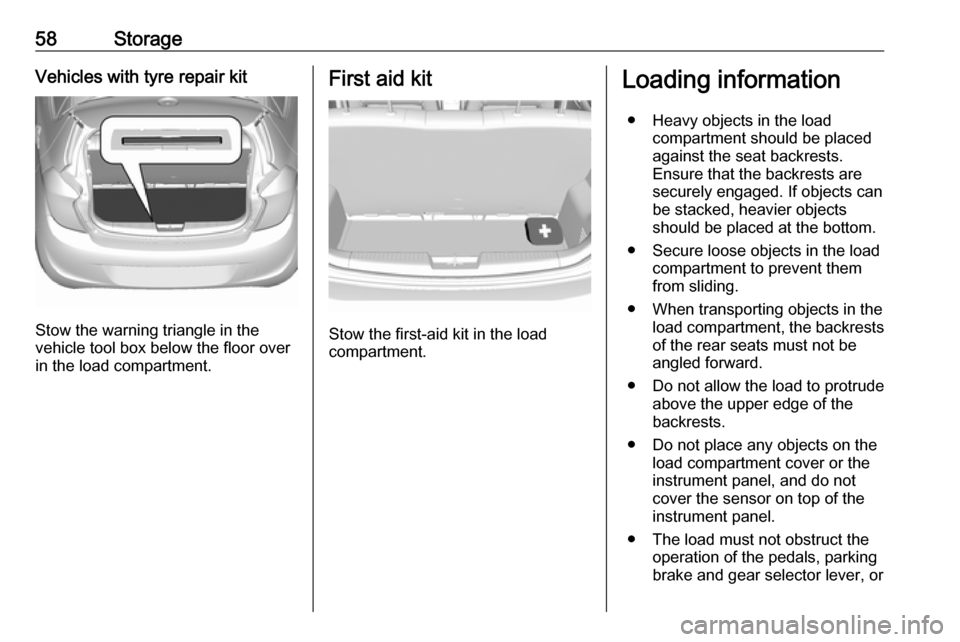OPEL KARL 2017 Manual user
Manufacturer: OPEL, Model Year: 2017, Model line: KARL, Model: OPEL KARL 2017Pages: 203, PDF Size: 5.39 MB
Page 51 of 203

Seats, restraints49Child restraint installation locations
Permissible options for fastening a child restraint system with a three-point seat belt
Weight class
On front passenger seat
On rear outboard seatsOn rear centre seat
activated airbagdeactivated airbagGroup 0: up to 10 kgXU 1U 2XGroup 0+: up to 13 kgXU1U2XGroup I: 9 to 18 kgXU1U2XGroup II: 15 to 25 kgXXU 2XGroup III: 22 to 36 kgXXU2XU:universal suitability in conjunction with three-point seat beltX:no child restraint system permitted in this weight class1:adjust seat backrest inclination as far as necessary to a vertical position to ensure that the belt runs forwards from
the upper anchorage point2:move the driver and/or passenger seat forwards and adjust seat backrest inclination as far as necessary to a vertical position to ensure that the child restraint system does not have any interference from the front seat backrest.
Page 52 of 203

50Seats, restraintsPermissible options for fitting an ISOFIX child restraint systemWeight classSize classFixtureOn front passenger seatOn rear outboard seatsOn rear centre seatGroup 0: up to 10 kgFISO/L1XXXGISO/L2XXXEISO/R1XILXGroup 0+: up to 13 kgEISO/R1XILXDISO/R2XILXCISO/R3XIL1XGroup I: 9 to 18 kgDISO/R2XILXCISO/R3XIL 1XBISO/F2XIL, IUFXB1ISO/F2XXIL, IUFXAISO/F3XIL, IUFXGroup II: 15 to 25 kgXILXGroup III: 22 to 36 kgXILX
Page 53 of 203

Seats, restraints51IL:suitable for particular ISOFIX restraint systems of the "specific-vehicle", "restricted" or "semi-universal" categories.
The ISOFIX restraint system must be approved for the specific vehicle type (refer to the vehicle type list of the child
restraint system)IUF:suitable for ISOFIX forward-facing child restraint systems of universal category approved for use in this weight classX:no ISOFIX child restraint system approved for this weight class1:only applicable for rear outer seat on passenger side with foremost seating position and backrest upright.
Note
Move the driver and/or passenger seat forwards and adjust seat backrest inclination as far as necessary to a vertical position to ensure that the child restraint system does not have any interference from the front seat backrest.
ISOFIX size class and seat device
A – ISO/F3:forward-facing child restraint system for children of maximum size in the weight class 9 to 18 kgB – ISO/F2:forward-facing child restraint system for smaller children in the weight class 9 to 18 kgB1 – ISO/F2X:forward-facing child restraint system for smaller children in the weight class 9 to 18 kgC – ISO/R3:rear-facing child restraint system for children of maximum size in the weight class up to 18 kgD – ISO/R2:rear-facing child restraint system for smaller children in the weight class up to 18 kgE – ISO/R1:rear-facing child restraint system for young children in the weight class up to 13 kgF - ISO/L1:left lateral facing position CRS (carry cot) for smaller children in the weight class up to 10 kgG - ISO/L2:right lateral facing position CRS (carry cot) for smaller children in the weight class up to 10 kg.
Page 54 of 203

52Seats, restraintsISOFIX child restraintsystems
Fasten vehicle-approved ISOFIX
child restraint systems to the ISOFIX
mounting brackets. Specific vehicle
ISOFIX child restraint system
positions are marked in the table by
IL.
ISOFIX mounting brackets on the
rear seats are indicated by the
ISOFIX logo on the backrest.
ISOFIX child restraint systems of
universal category positions are
marked in the table by IUF.
Remove rear head restraint before
mounting a child restraint system, if
required 3 35.
Route, attach, and tighten the top
tether according to your child restraint instructions.
Top-tether fastening eyes The vehicle has two fastening eyes
on the back of the rear seats.
Top-tether fastening eyes are marked
with the symbol : for a child seat.
In addition to the ISOFIX mounting,
fasten the Top-tether strap to the
Top-tether fastening eyes.
Route, attach, and tighten the top
tether according to your child restraint instructions.
ISOFIX child restraint systems of
universal category positions are
marked in the table by IUF.
Remove rear head restraint before
mounting a child restraint system, if
required 3 35.
Page 55 of 203

Storage53StorageStorage compartments................53
Glovebox ................................... 53
Cupholders ................................ 53
Centre console storage .............54
Load compartment .......................54
Load compartment cover ...........56
Rear floor storage cover ............57
Warning triangle ........................57
First aid kit ................................. 58
Loading information .....................58Storage compartments9Warning
Do not store heavy or sharp
objects in the storage
compartments. Otherwise, the
storage compartment lid could
open and vehicle occupants could be injured by objects being thrown
around in the event of hard
braking, a sudden change in
direction or an accident.
Glovebox
Pull lever to open the glovebox cover.
The glovebox features an adapter for
the locking wheel bolts.
The glovebox should be closed whilst driving.
Cupholders
Cupholders are located in the centre
console.
Page 56 of 203

54StorageCentre console storage
The storage is used for small articles.
Load compartment
Load compartment extensionCaution
First fold up the rear seat cushion
before folding the rear seat
backrest.
Disregard may lead to damage to
the rear seat.
Note
To ensure sufficient room for rear
seat cushion operation, slide the
front seats forward and move the
front seat backrest upright.
1. Pull up the front of the rear seat cushion to release it.
2. Guide the rear of the rear seat cushion to an upright position.
3. Remove the rear seat head restraints 3 35.
Page 57 of 203

Storage55
4.Pull the release knob on top of the
rear backrest.
5. Fold down the backrest and insert
the rear seat head restraints into
the pockets.
6. Put the seat belts for the outboard
seats into the belt guides.
7. Adjust the front seats to the desired position.
To return the backrest to the original
position:
1. Lift the backrest up and pull out the seat belt from the belt guides.
Push backrest firmly into place.
9 Warning
When folding up, ensure that
backrests are securely engaged in position before driving. Failure to
do so may result in personal injury
or damage to the load or vehicle in the event of hard braking or a
collision.
Ensure the seat belts are not
pinched by the latch.
2. Reinstall the rear head restraints.
3. Place the rear part of the seat cushion in its original position.
Note
Make sure the seat belts are not
twisted or caught under the seat
cushion.
4. Push the front part of the seat cushion down firmly until it
latches.
The centre rear seat belt may lock
when you raise the backrest. If this
happens, allow the belt to go back all the way and repeat operation.
If the seat belt is still locked, fold down the seat cushion and try again.
To return the rear seat cushion, put
the rear part of the seat cushion in its original position ensuring that the
seat belt buckle straps are not twisted
Page 58 of 203

56Storageor caught under the seat cushion,
then push the front part of the seat
cushion firmly down until it latches.Caution
When returning rear seat backrest
to the upright position, place the
rear seat belt and buckles
between the rear seat backrest
and one cushion. Make sure the
rear seat belt and buckles do not
get pinched under the rear seat
cushion.
Ensure the seat belts are not twisted or caught in the seat
backrest and are arranged in their proper position.
To remove the rear seat cushion,
push the hinges in direction of arrow.
Load compartment cover Do not place heavy objects on thecover.Removing
Unhook retaining straps from tailgate.
Lift cover at the rear and push it
upwards at the front.
Remove the cover.
Stowing
When the load compartment is fully
loaded, stow the load compartment
cover on the rear seats or remove
from vehicle.
Fitting
Engage cover in side guides and fold downwards. Attach retaining straps to
tailgate.
Page 59 of 203

Storage57Rear floor storage coverRear floor cover
Lift up rear floor cover to gain access
to the tyre repair kit, vehicle tools and
warning triangle.
On versions with spare wheel, the
spare wheel is located under the rear
floor cover together with the vehicle
tools.
Tools 3 155.
General hint9 Warning
For safety reasons, stow all parts
in the load compartment in its
position, always drive with a
closed rear floor cover and, if
possible, with folded up rear
backrests.
Otherwise, vehicle occupants
could be injured by objects being
thrown around in the event of
sharp braking, a sudden change in direction or an accident.
Warning triangle
Vehicles with spare wheel
Stow the warning triangle in the load
compartment.
Page 60 of 203

58StorageVehicles with tyre repair kit
Stow the warning triangle in the
vehicle tool box below the floor over
in the load compartment.
First aid kit
Stow the first-aid kit in the load
compartment.
Loading information
● Heavy objects in the load compartment should be placed
against the seat backrests.
Ensure that the backrests are
securely engaged. If objects can
be stacked, heavier objects
should be placed at the bottom.
● Secure loose objects in the load compartment to prevent themfrom sliding.
● When transporting objects in the load compartment, the backrestsof the rear seats must not beangled forward.
● Do not allow the load to protrude above the upper edge of the
backrests.
● Do not place any objects on the load compartment cover or theinstrument panel, and do notcover the sensor on top of theinstrument panel.
● The load must not obstruct the operation of the pedals, parking
brake and gear selector lever, or